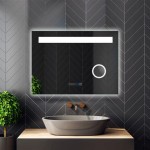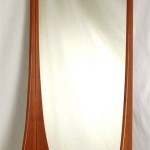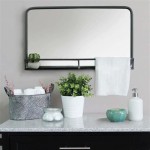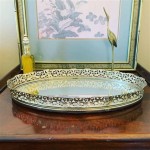How To Hang Mirror Tiles On Wall
Mirror tiles offer a versatile and stylish way to enhance any room, adding light, depth, and a touch of glamour. Whether aiming for a full mirrored wall or a smaller decorative accent, proper installation is crucial for a polished, lasting result. This article provides a comprehensive guide to successfully hanging mirror tiles on a wall.
Preparing the Wall Surface
The wall surface plays a vital role in the adhesion and overall appearance of the mirror tiles. Before beginning, ensure the wall is clean, dry, and free of any dust, debris, or loose paint. For painted walls, a light sanding may be necessary to create a slightly rough surface for better adhesion. If dealing with wallpaper, it's generally recommended to remove it completely for optimal results. Any imperfections or holes in the wall should be filled and sanded smooth. For particularly smooth or glossy surfaces, applying a primer specifically designed for smooth surfaces can significantly improve adhesion.
Choosing the Right Adhesive
Selecting the appropriate adhesive is crucial for the longevity and stability of the mirror tiles. Several options are available, each with its own benefits and drawbacks. Mirror mastic, a specialized adhesive designed for mirrors and glass, is a popular choice due to its strong bonding properties. Construction adhesive can also be used, offering high strength and versatility. Double-sided mounting tape is a convenient option for smaller tiles or lighter applications, but it may not be suitable for larger, heavier tiles or areas exposed to moisture. When choosing an adhesive, consider the weight and size of the tiles, as well as the environmental conditions of the room.
Planning the Layout and Placement
Before applying any adhesive, it's essential to plan the tile layout carefully. Measure the wall area accurately and determine the number of tiles needed. Dry-fitting the tiles on the floor beforehand allows for precise arrangement and helps visualize the final result. This also helps identify any potential issues with uneven tile sizes or wall irregularities. When planning the layout, consider the spacing between tiles, which can be adjusted using spacers for uniformity. Mark the desired layout on the wall with a pencil or chalk line to serve as a guide during installation.
Applying the Adhesive and Mounting the Tiles
Once the layout is finalized, begin applying the adhesive. If using mirror mastic or construction adhesive, apply a small amount to the back of each tile, following the manufacturer's instructions. Avoid applying too much adhesive, as it can squeeze out from the sides and create a mess. For double-sided mounting tape, ensure the backing is removed before applying the tile to the wall. Carefully place each tile onto the wall, aligning it with the marked layout. Apply gentle pressure to ensure proper adhesion. Spacers can be inserted between tiles to maintain consistent spacing. Continue applying the tiles one by one, following the planned layout.
Finishing Touches and Considerations for Different Surfaces
After all tiles are installed, allow the adhesive to cure completely according to the manufacturer's instructions. Once cured, remove any excess adhesive carefully with a razor blade or a suitable cleaning agent. Grouting may be necessary for certain tile types or desired aesthetic effects. Apply grout according to the manufacturer's instructions, ensuring even application and proper cleaning. For tiling around outlets or light fixtures, careful measurement and cutting of the tiles may be required. Specialized tile cutters can be used for precise cuts. When applying tiles to uneven surfaces like brick or textured walls, additional preparation might be needed to ensure a smooth and even surface for proper adhesion.
Dealing with Challenging Areas and Complex Designs
Installing mirror tiles around corners or curved surfaces requires careful planning and execution. Flexible mirror tiles are available for curved surfaces, providing a seamless look. For complex designs involving different tile sizes or shapes, creating a detailed template beforehand can simplify the installation process. Consider using a laser level to maintain accuracy and alignment, especially for intricate patterns. For areas with high humidity, such as bathrooms, ensure proper ventilation to prevent moisture buildup, which can affect the adhesive and the mirror's backing.
Maintenance and Cleaning
Maintaining the shine and clarity of mirror tiles is relatively simple. Regular cleaning with a glass cleaner and a soft cloth will prevent streaks and buildup. Avoid using abrasive cleaners or harsh chemicals, as they can damage the mirror surface. For stubborn stains or residue, a solution of warm water and vinegar can be effective. Regularly inspect the tiles for any signs of loosening or damage and address them promptly to prevent further issues. Appropriate maintenance will ensure the longevity and aesthetic appeal of your mirror tile installation.

How To Hang Mirrors On Tile 3 Ways A Bonus The Palette Muse

How To Hang A Mirror On Tile Wall Remington Avenue

How To Hang Mirrors On Tile 3 Ways A Bonus The Palette Muse

How To Hang Mirrors On Tile 3 Ways A Bonus The Palette Muse

How To Use Decorative Mirror Tiles In Interior Design

Diy Mosaic Tile Bathroom Mirror Centsational Style

Mirror Walls And Tiles Mirrorworld

Mirrored Hexagonal Wall Tiles Pack Mirror Living Room Design

How To Hang A Heavy Mirror Without Nails S Or Drilling Velcro Brand

How To Hang A Bathroom Mirror Over Tile Wainscoting Mimzy Company








